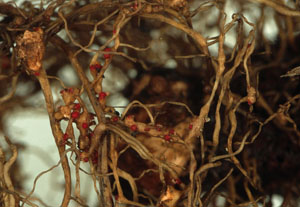Dagger Nematodes Root Knot Nematodes Citrus Nematodes Lesion Nematodes Ring Nematodes Stubby Root Nematodes Management More info
Stephen Jordan, University of Wisconsin-Madison
What are nematodes?
Nematodes are wormlike non-segmented invertebrate animals found in marine, freshwater, and terrestrial habitats. Plant-parasitic nematodes have a cell piercing feeding apparatus called a stylet, which is used to extract nutrients from the plant cell. Plant parasitic nematodes feed on roots, reducing vigor and yield of the vine usually in irregular patterns across the vineyard. Damage patterns are frequently associated with soil textural differences. Nematodes create openings in roots through which other microorganisms can enter, and some species are able to transmit viruses from one vine to another. All these factors increase the susceptibility of plants to environmental stress, including drought stress and winter injury. Nematodes are transmitted by anything that can move soil, including machinery, wind, and water. There are six main groups of plant parasitic nematodes that cause damage to grapevines; dagger, root knot, citrus, lesion, ring, and stubby root nematodes.
Dagger Nematodes (Xiphinema americanum and X. index)
Dagger nematodes feed on the roots, often resulting in swollen root tips and preventing the roots from functioning properly, reducing vigor and yield. Roots often die as a result of this feeding. The greater danger of dagger nematodes to grapevines is through transmission of viruses such as grape fanleaf virus, tobacco and tomato ringspot virus, and peach rosette mosaic virus.
Root Knot Nematodes (Meloidogyne incognita, M. javanica, M. arenaria, and M. hapla)
Root knot nematodes penetrate grapevine roots and induce swelling, causing the formation of galls. Galls disrupt the uptake of nutrients and water, decreasing vigor and yield. Affected vines are generally in circular or oval-shaped areas in the field.
Citrus Nematode (Tylenchulus semipenetrans)
Citrus nematodes establish feeding sites with their heads embedded inside the roots and their posterior ends outside the roots. Citrus nematodes produce a gelatinous matrix around the roots, causing soil to cling to the roots, giving them a “dirty” appearance when removed from the soil. Their feeding disrupts the uptake of nutrients and water, and interferes with plant growth, causing slow decline, loss of feeder roots, poor vine vigor and loss of yield.
Lesion Nematode (Pratylenchus vulnus)
Lesion nematodes feed on roots either from outside the root or by entering along the root and moving between cells. High population levels in newer plantings can cause the formation of brown root lesions and restricted root growth.
Ring nematode (Mesocriconema xenoplax)
Ring nematodes feed on the tips and sides of roots and reduce vine vigor and yield.
Stubby Root Nematodes (Paratrichodorus spp.)
Stubby root nematodes are more common in sandy soils. Feeding of stubby root nematodes reduce vigor and yield in heavily infested vines.
Cultural Management Options
- Before making management decisions, it is important to identify the type of nematode species present and determine their relative population with the vineyard. This can be done by taking soil samples to a testing laboratory. Prior to sampling, contact the testing laboratory to get the proper sampling procedure.
- Plant certified nematode-free rootings and select nematode-resistant rootstocks.
- When replanting a site with heavy nematode infestation, a fallow or host-free period of one to several years is recommended, depending on the type of nematode present. This allows for decline of the nematode population.
- Some cover crops can reduce nematode populations and should be considered prior to new plantings and re-planting of established vineyards. The cover crop selected is dependent on the species of nematode present.
Chemical Management Options
Pre-plant nematicidal fumigants and postplant nematicides are available for control of nematodes. These products are under increasing regulation, therefore, availability might be limited. Make sure to read labels before choosing a product to ensure that it is allowed in your state and that application method and rates follow the label recommendations.
Recommended Links
Pest Management Guidelines for Nematodes, University of California
Midwest Small Fruit and Grape Spray Guide
Overview of Vineyard Floor Management
Grape Disease Management Overview
Reviewed by Damon Smith, Oklahoma State University and Kevin Ker, Brock University


